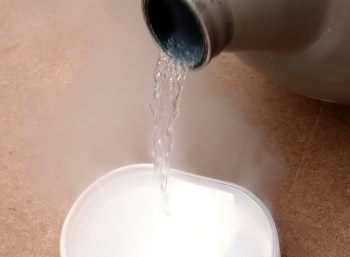property>specific heat capacity
What is Specific Heat Capacity?

The specific heat capacity of a substance, chemical compound, or molecule, is a measure of the amount of heat energy necessary to increase the temperature of a unit quantity of that substance by a given temperature interval. Water, for example, has a specific heat capacity of 4.186 joules/gram °C. In other words, in order to increase the temperature of one gram of liquid water by one degree celsius, you will have to add introduce 4.186 joules of heat energy into the system. The symbol for specific heat is denoted as c or sometimes C, depending on how the substance is measured. The SI units for specific heat are J/(kg.K).
There equation relating specific heat capacity to heat energy and temperature can be written as follows:
Q = mcΔT
Here, Q is taken to be the heat energy put into a certain amount of a substance with mass m, c is the specific heat of the substance, and ΔT is the temperature change. Rearranging this equation for c, we get:
c = Q/(m.ΔT)
which restates the units of specific heat as an energy quantity divided by a mass and change in temperature.
Many people get confused in dealing with phase changes and specific heat. Let’s assume we have a litre of water at room temperature that we want to convert to steam and we want to know the change in enthalpy that will be necessary in order to raise the temperature of the water to its boiling point and then change its state to water vapour. Contrary to what one might think, the enthalpy change is not continuous between phases such that the change in enthalpy required to get water from a liquid state to a gas state at boiling temperature is the same as the change in enthalpy required to heat water up an extra degree C. The specific heat value for water differs depending on the state of water. One must also add in the change in enthalpy of vaporization between the phase transition of liquid water to water vapor in order to have an accurate picture of the total enthalpy change necessary between phases.
Most values of specific heat are nearly constant for a given temperature range and state, except at very low temperatures. In such cases, the laws of quantum mechanics become increasingly significant and specific heat no longer behaves classically. The Einstein-Debye model of specific heat, however, will predict specific heat values at these low temperatures.
Another important factor that has an effect on specific heat is the varying degrees of freedom of motion available in many different chemical compounds. Certain, more complex, molecules have many degrees of freedom, and this has an effect on the amount of energy that can be stored in the compound. In some cases, a change in temperature can affect a change in the degrees of freedom available, which can cause the specific heat of the substance in question to change. Nitrogen is one such example. At room temperature, nitrogen has five degrees of freedom, but at higher temperatures nitrogen gains two more degrees of internal freedom. With the opening up of these extra degrees of freedom, nitrogen gas is able to store more energy, therefore increasing its specific heat capacity.